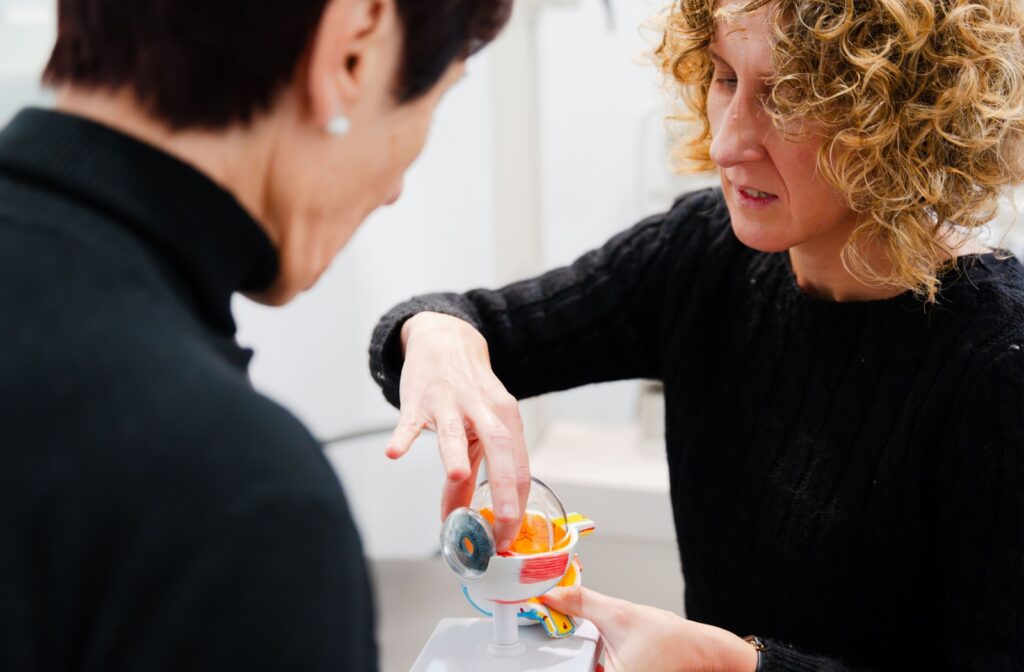Dry eyes are more than just a cycle of annoying symptoms. Along with persistent discomfort, dry eye can affect the sharpness of your vision (even with glasses or contacts), and for some people, even lead to headaches.
While there is no direct link, persistent dryness can stress the visual system, which may contribute to or worsen headaches.
Finding relief from dry eyes is simple with innovative therapies. With consistent management, you can keep dryness and uncomfortable headaches at bay.
A Closer Look at Dry Eye
Dry eye is a chronic condition that occurs when you aren’t producing enough quality tears or when tears evaporate too quickly from the eye’s surface. Apart from dryness, common symptoms of dry eye include redness, irritation, blurry vision, and watery eyes.
More than just helping you express complex emotions, your tears protect your eyes from irritants and debris, and keep the eye’s surface moist for comfort and visual clarity.
The tear film covers the eye’s surface and consists of three layers:
- The oily outer layer: Provides a barrier to prevent tears from evaporating too quickly.
- The watery middle layer: Keeps the eyes hydrated.
- The mucous inner layer: Helps tears stick evenly across the eye’s surface.
A disruption in any part of the tear film can lead to dry eye and can include factors such as:
- Aging: As you grow older, tear production naturally decreases.
- Environmental conditions: Living in windy or dry climates, experiencing smoky weather, or spending long hours on digital screens can accelerate tear evaporation.
- Contact lens wear: Improper contact lens care or wearing your lenses for extended periods can disrupt tear distribution and stability.
- Meibomian gland dysfunction (MGD): Meibomian glands are tiny oil-producing glands along your eyelids, which secrete the oily component of your tear film. Clogs or malfunctioning glands affect oil secretion, leading to faster tear evaporation.
Dry eye is far more than mild discomfort. Without proper management, this condition can significantly strain your eyes, causing blurry vision and irritation, which in turn can affect your quality of life.
Do Dry Eye & Headaches Share a Link?
If you’ve experienced dry eye and headaches together, you’re not imagining things. Although researchers are still exploring the connection between the two concerns, studies show there may be a link.
One study found that those with migraines are more likely to experience dry eye symptoms, such as inflammation, tear film instability, and poor tear quality production. Another study found that differences in the eye structure of people with migraines might contribute to dry eye symptoms.
The connection lies in how dry eye can strain your visual system. Here’s a breakdown of how dry eye can trigger headaches:
- Eye strain: When your eyes are dry, they work harder to focus, especially during activities like reading, using digital screens, or driving. This increased effort can eventually lead to tension and discomfort around your head and eyes, manifesting as headaches.
- Chronic inflammation: Inflammation in the tear film or the eye’s surface often accompanies dry eye. This can contribute to the uncomfortable sensations associated with headaches.
- Nerve stimulation: The cornea, rich with nerve endings, can become irritated when the tear film is unstable. This overstimulation of the nerves may cause or worsen headaches.
With that said, it’s important to note that dry eye may not directly cause headaches for everyone. Other factors, such as stress, lack of sleep, and poor posture while using screens, can also play a significant role.
However, if you frequently experience both symptoms together, addressing the root cause of your dry eye is likely a step toward overall relief.

Dry Eye Treatment Options
Apart from worsening symptoms, delaying dry eye treatment can lead to serious complications. Although we have yet to find a permanent cure for dry eye, we can effectively manage symptoms to achieve lasting relief.
At-home remedies, such as artificial tears or a warm compress mask, can help, but they don’t address the root cause of dry eye. Tackling the underlying issue is crucial, not only for eye comfort but also for potentially alleviating the headaches associated with this condition. Advanced therapies offer an effective solution.
Comprehensive Dry Eye Diagnosis
Every successful treatment begins with a thorough understanding of the issue.
Our diagnostic tools include testing for tear osmolarity, tear breakup time (TBUT), and tools like InflammaDry to measure inflammation levels. Identifying the exact problem enables us to create an effective treatment plan tailored to your needs.
Meibomian Gland Expression
MGD is one of the leading causes of dry eye. We use a special procedure to gently express the meibomian glands, clearing any disruptions or clogs to restore balance to the tear film and reducing excessive tear evaporation.
Zocular Eyelid System Treatment (ZEST)
If bacteria and debris contribute to your dry eye symptoms, we may recommend ZEST.
This gentle exfoliation treatment helps eyelids stay clean and healthy while promoting balanced tear film production.
Medicated Eye Drops
For issues such as inflammation or insufficient tear production, we provide medicated eye drops to address the root of the problem. These drops go beyond mere hydration, helping to reduce inflammation and stabilize tear production over time.
Take Control of Your Eye Health
Dry eye is common, but the headaches that some people experience aren’t. Managing dry eye can help improve your comfort, reduce eye strain, and minimize the headaches that often accompany this condition.
Apart from longer relief, the beauty of innovative therapies means you can combine at-home remedies to maintain the results of your treatment. As always, our expert team is happy to discuss which strategies align with your visual concerns and overall eye health. The road to comfort and relief is closer than you think. An initial consultation with Dr. Rehana Manji & Associates is all it takes.


